Creating a DIY dog fence is an enjoyable and practical way to give your pup the freedom to roam while keeping them safe. You don’t need to be a pro or spend a ton of cash—just a few simple materials and some elbow grease, and you can set up a perfect space for your dog to play. Let’s break down the process!
Adding Gates for Easy Access
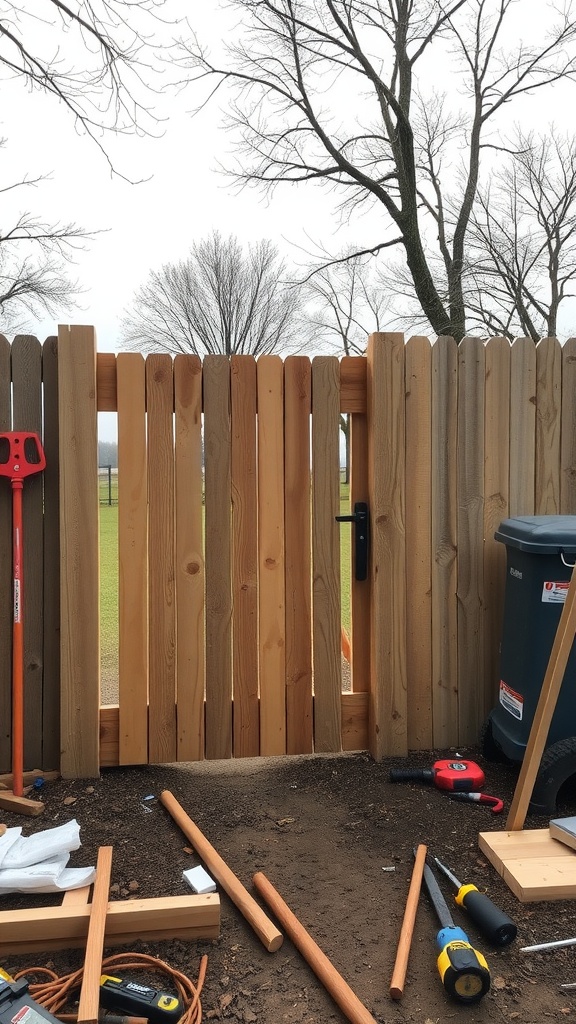
When building a DIY dog fence, adding a gate is a simple yet important step. This image shows a wooden gate framed by sturdy planks. The gate allows you to easily enter and exit the fenced area, which is essential for regular use.
Look at how the gate blends well with the overall fence. It’s made of the same material, ensuring a cohesive look. The latch on the gate is easy to operate, making it convenient for quick access. This way, you can let your dog in and out without hassle.
Having a gate also provides a secure way to keep your pet safe while allowing freedom to roam in the yard. It’s a vital addition that balances safety and accessibility. Plus, you can personalize the design based on your style!
Incorporating Latches and Locks for Security

When building a DIY dog fence, security is a top priority. The image shows a close-up of a latch on a fence gate. This latch plays an important role in keeping your dog safe inside the yard.
Using quality latches and locks ensures that your pet cannot escape easily. You want something sturdy and reliable. The latch in the photo appears durable, which is essential for any DIY dog fence.
Consider different types of locks as well. Some may require a key, while others might have a simple sliding mechanism. Think about what works best for your situation. A secure latch gives peace of mind, letting you know your furry friend is safe.
Also, don’t forget to check the latch regularly for wear and tear. Even the best lock can weaken over time. A quick inspection can save you from a potential escape.
Creating a Strong Foundation for Your Fence
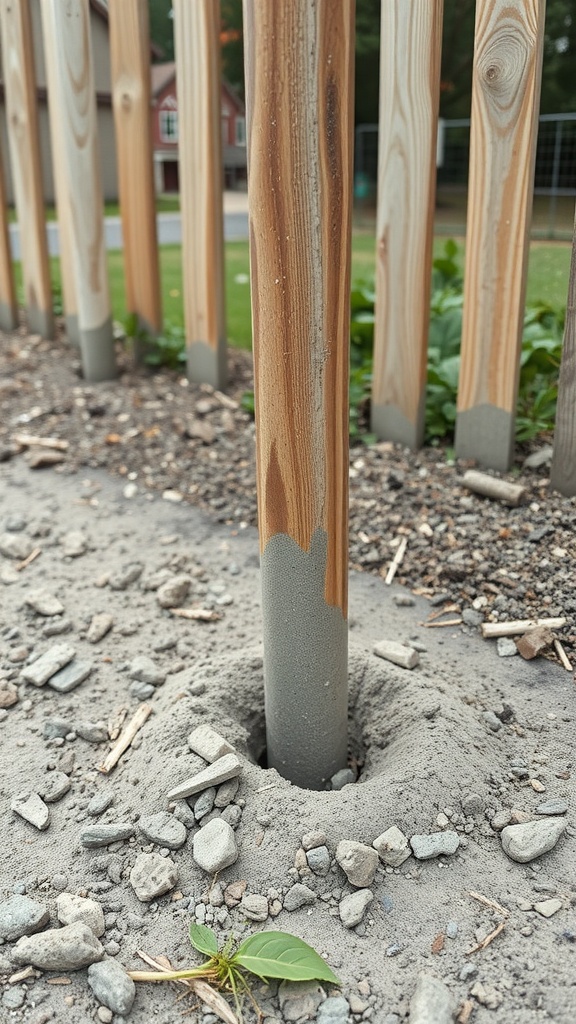
Setting up a dog fence starts at the base. The image shows a fence post firmly anchored in concrete. This strong foundation is key to preventing any wiggle or movement, which is essential for both durability and safety.
To create a solid base, dig a deep hole for each post. The depth should be at least one-third of the post’s length. This helps ensure stability against wind and any playful pushes from your dog.
After placing the post in the hole, fill it with concrete. This will hold the post securely in place. Don’t forget to let it cure properly before moving on to the next steps. This process may take a day, but it’s worth the wait for a reliable fence.
Remember, a strong foundation leads to a sturdy fence. Your dog will appreciate the security it provides, allowing them to roam freely within their space.
Selecting the Right Materials for Your Fence
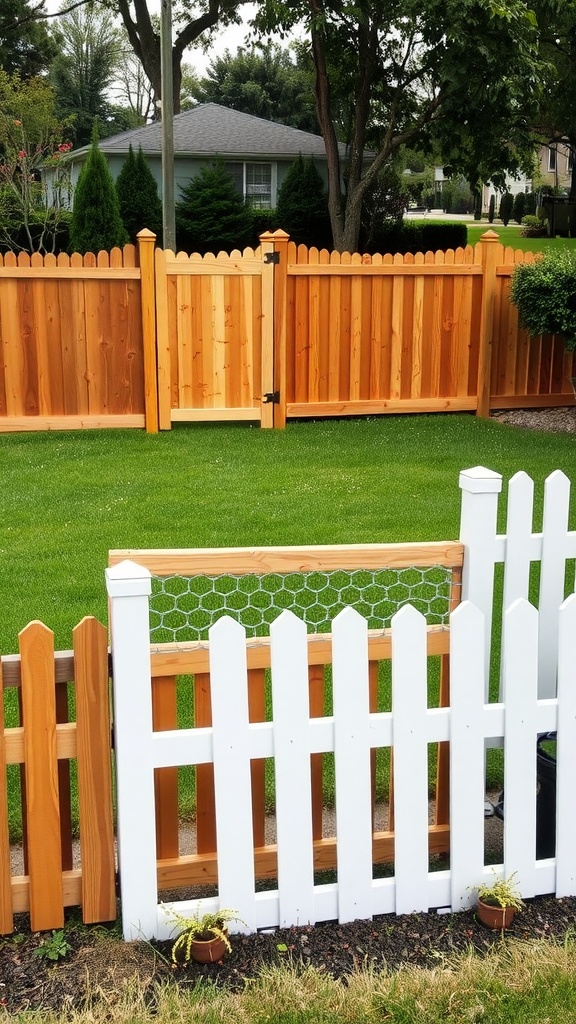
When building a DIY dog fence, choosing the right materials is key to keeping your pup safe and happy. The image shows two different types of fences: a wooden fence and a white picket fence with a wire top for added security.
The wooden fence offers durability and strength. Cedar is popular for its natural resistance to decay. It also blends beautifully with outdoor spaces. On the other hand, the white picket fence adds charm while the wire provides a barrier against smaller animals.
Think about the height of the fence too. Taller fences can prevent jumping or climbing, while a shorter design may be more about style. If your dog loves to dig, consider adding an underground barrier.
Keep in mind the local weather conditions. Materials should withstand rain, sun, or snow without deteriorating quickly. Also, think about maintenance. Some materials require more upkeep than others.
Choosing the Appropriate Height for Your Fence
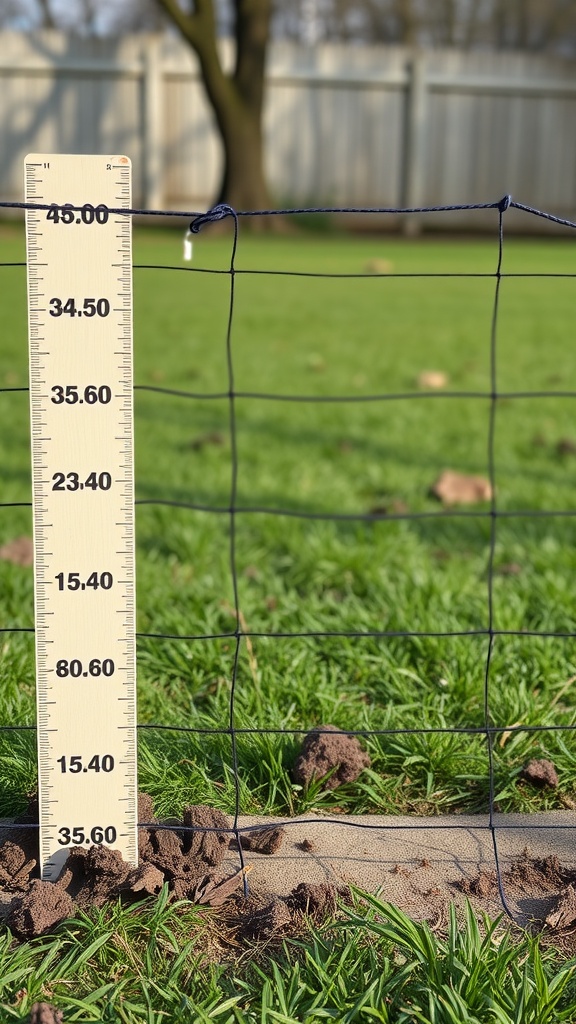
When it comes to building a DIY dog fence, height is a big deal. The image shows a measuring stick next to a section of the fence, indicating its height. You want to ensure your fence is tall enough to keep your pup safely contained while also considering their jumping abilities.
Generally, a height of around 4 to 6 feet works for most medium to large dogs. Smaller breeds might require less, but it’s best to err on the side of caution. If you have a high-energy dog that loves to jump or climb, aim for the taller end of that range.
Think about your dog’s behavior. Does your dog like to dig under fences? If so, you may need to add some underground barriers. The right height can stop them from escaping easily, while the right setup prevents any sneaky attempts at digging.
Finally, make sure the fence’s height is comfortable for you as well. You don’t want a structure that’s hard to maintain or hard to see over. Keep these factors in mind, and you’ll have a solid fence that works for both you and your pet!
Installing Fencing Panels: Step-by-Step Process
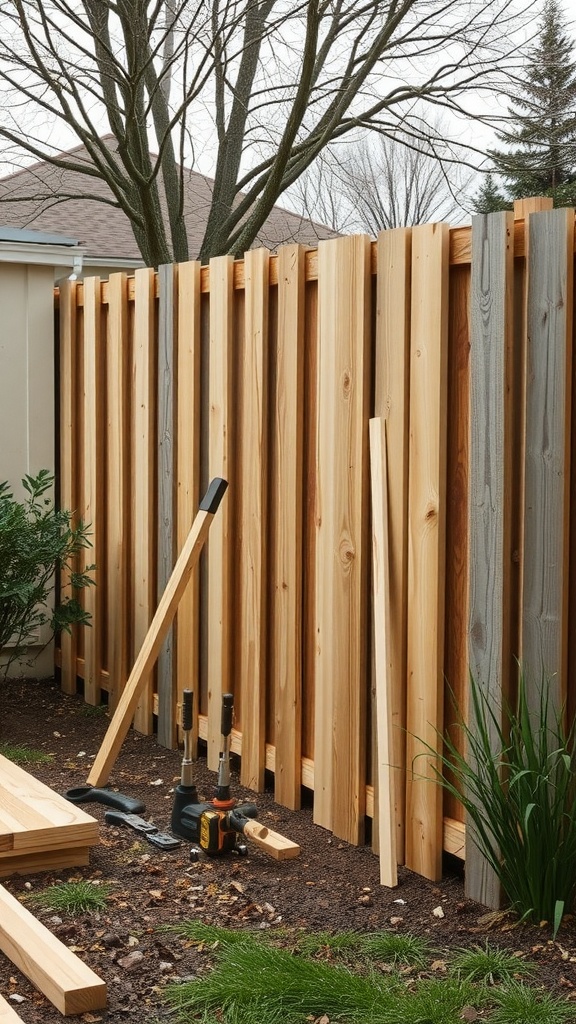
Creating a DIY dog fence can be an exciting project. In the image, you see a well-structured setup for fencing panels. Wooden panels are lined up, ready to provide a safe space for your dog. It’s essential to have a clear plan before you start this installation.
The first step is measuring your yard. You want to know how many panels you need and the layout that works best. Use stakes and string to outline where the fence will go. This helps visualize the space.
Next, prepare the ground where the panels will be installed. Make sure the area is free of debris and level. Sometimes, you might need to dig small holes for the posts, depending on the type of panels you choose.
Once the ground is ready, it’s time to set the panels in place. Stand them upright and secure them with the help of brackets or nails. Make sure they’re sturdy. You don’t want your dog to push through!
After the panels are up, take a step back and check your work. Look for any gaps or loose areas that might need reinforcing. Your dog’s safety is the priority, so double-check everything. And there you have it! A solid, reliable dog fence to keep your pet happy and secure.
Measuring Your Yard for Optimal Fence Placement
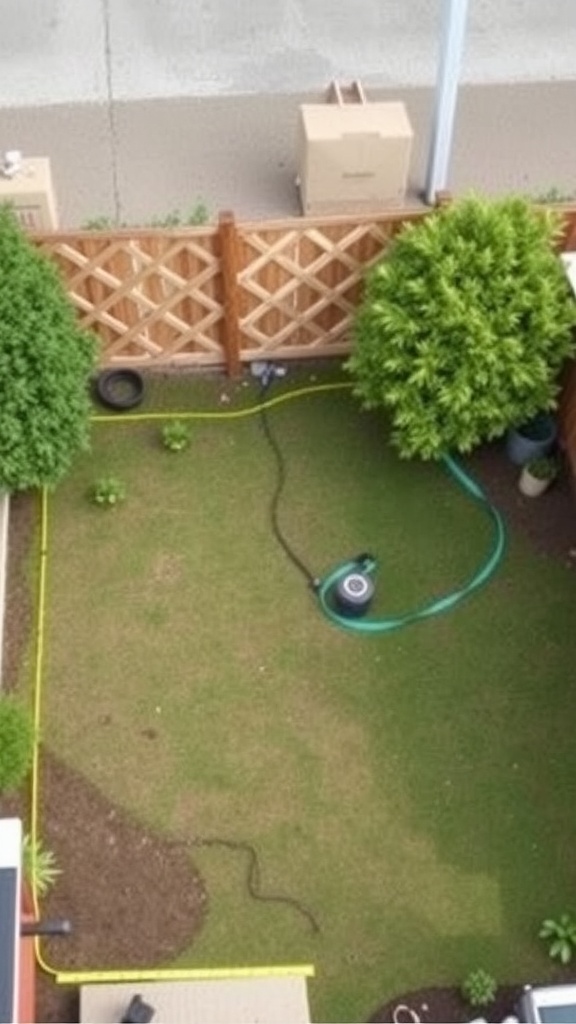
Before starting your DIY dog fence project, measuring your yard is key. The image shows a yard where someone is already taking careful steps to outline the fence placement. You can see a garden hose and some yellow tape marking the area.
Begin by identifying the boundaries of your yard. Look for physical markers like trees or existing fences. Using a measuring tape, note the distances, ensuring you account for any curves or unique shapes in your yard.
The Yellow tape here is a handy tool for visualizing where the fence will go. It helps to see how much space your pup will have to roam. Make sure to measure from the house to the edge of the property for accurate placement.
Don’t forget to check local regulations too. Sometimes, there are rules about how close fences can be to property lines or what materials you can use. Knowing these details will save you time and effort later on.
Design Ideas for an Attractive Dog Fence
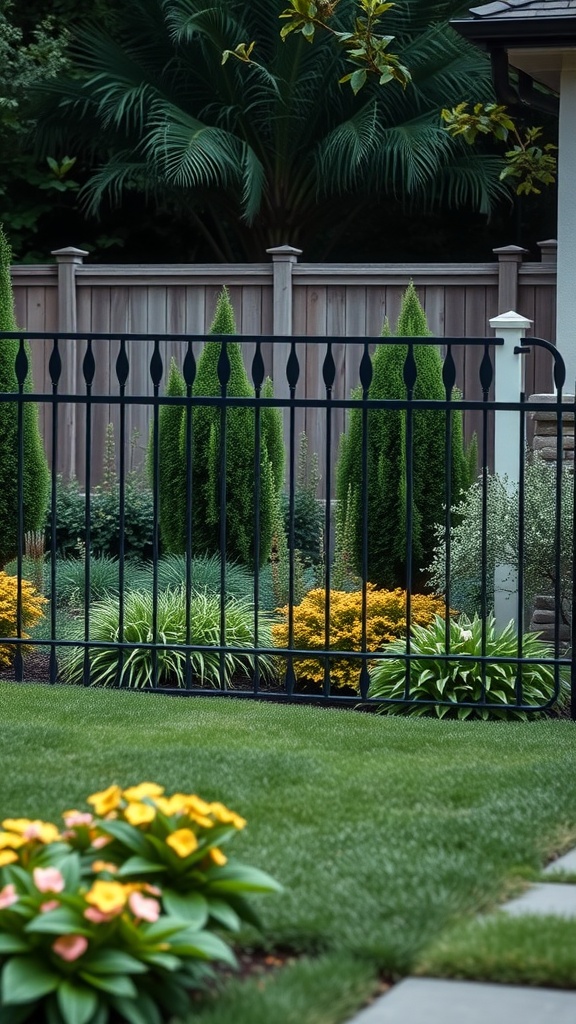
Creating a dog fence that looks good can enhance your yard while keeping your pup safe. The image shows a stylish black fence that complements the natural beauty of the garden.
This fence features elegant lines and a modern design, making it a great focal point. The surrounding greenery, with neatly trimmed shrubs and colorful flowers, adds charm to the overall look.
Choosing a fence that matches your home’s style is key. For instance, a black metal fence, like in the image, can add a contemporary touch. You could also consider wood fencing for a more rustic feel, or even a picket fence for a classic look.
Incorporating plants near the fence can soften its appearance. The vibrant yellow and pink flowers in the image show how well plants can blend with the fence, creating a warm and inviting atmosphere.
Lighting can also play a role. Adding solar lights along the fence not only enhances safety during the evening but also adds a cozy ambiance.
Designing a dog fence doesn’t have to be boring. With a little creativity, you can create a beautiful and functional space for your dog to enjoy.
Building a Fence on Sloped Terrain
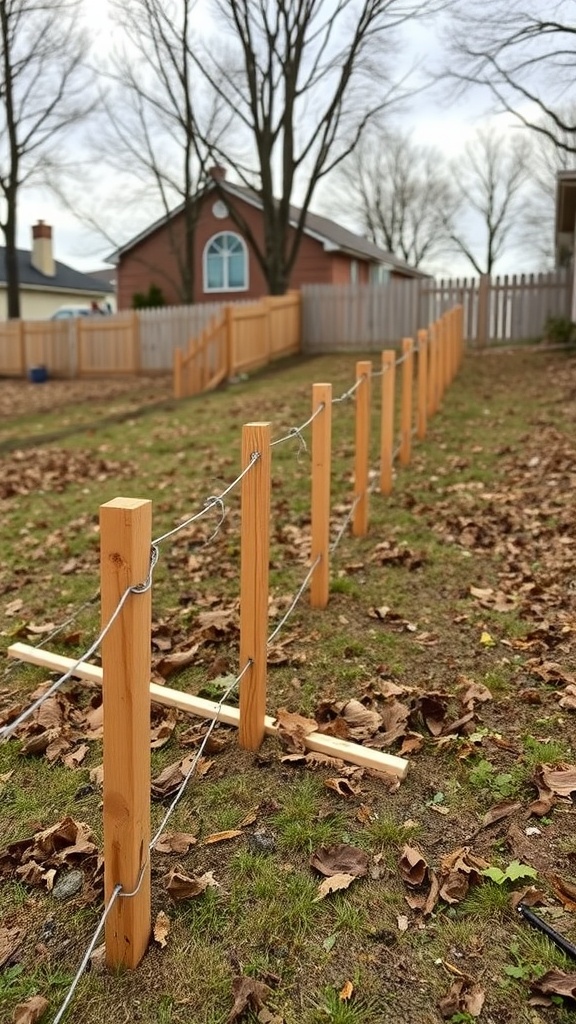
Building a dog fence on a slope can be tricky, but it’s totally doable! The image shows the beginning stages of such a project. You can see wooden posts being set up, which are crucial for maintaining the structure and stability of the fence.
When dealing with sloped land, the key is to make sure each post is level. Even if the ground is uneven, your fence should look straight and secure. The posts need to be anchored properly, ensuring they won’t shift over time.
Using wire to connect the posts helps create a solid barrier. This is especially useful when your dog loves to dig or jump. The wire adds an extra layer of security to contain your pet. Make sure to check the tension in the wire to keep it taut and effective.
As you continue building, it’s important to measure each section carefully. This helps maintain a consistent height across the sloping terrain. If the slope is steep, consider using steps in the fence design to create a more gradual incline.
Overall, this image captures the early efforts in a project that promises to keep your furry friend safe while adding charm to your yard.
Weatherproofing Your Dog Fence
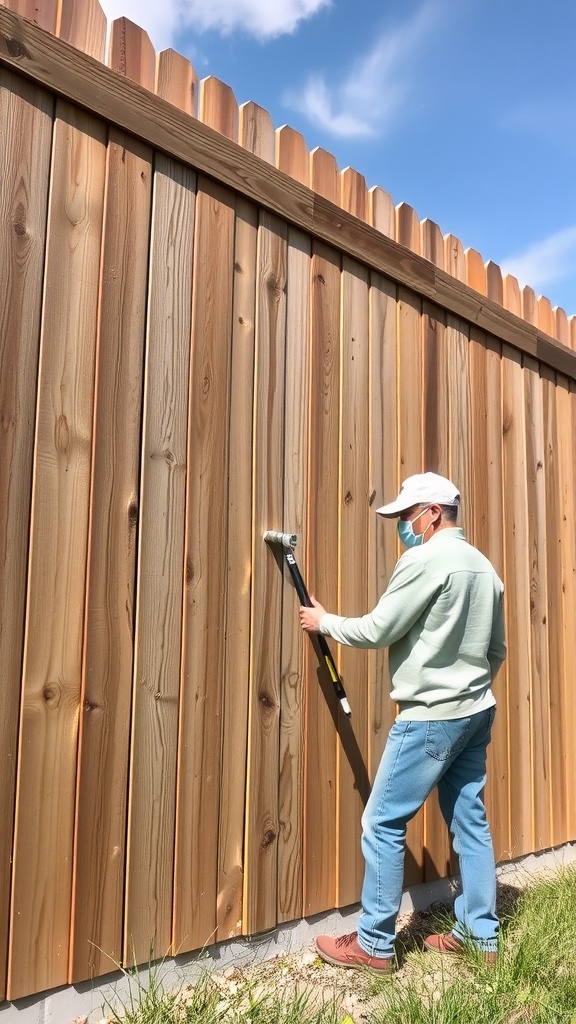
Weatherproofing your dog fence is key to keeping it sturdy and reliable. In the image, we see someone applying a protective coating to a wooden fence. This is an important step to ensure the wood can withstand rain, sun, and other elements.
Choosing the right finish is crucial. A good weatherproof sealant will not only enhance the appearance but also prevent rotting and warping over time. Look for products specifically made for outdoor use.
Regular maintenance, like reapplying sealant every few years, will keep your fence in top shape. It’s a simple way to extend the life of your investment and provide a safe space for your dog.
Remember, a well-maintained fence protects your dog from escaping and keeps unwanted animals out. So grab that paint roller and make sure your fence is ready for anything Mother Nature throws at it!
Painting or Staining Your Fence for Durability
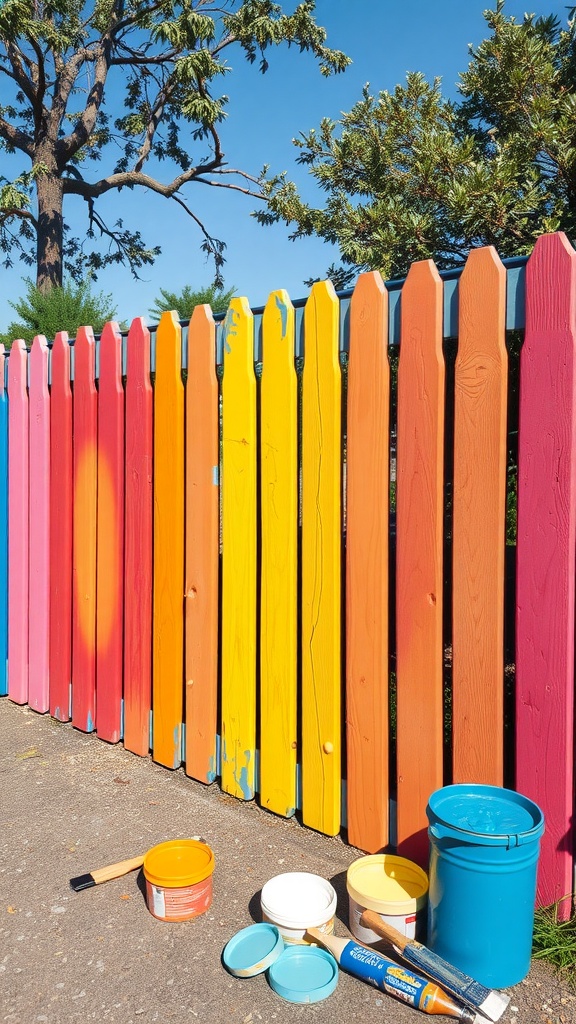
A freshly painted or stained fence can bring a bright and cheerful vibe to your yard. The image shows a colorful fence with vibrant hues of red, yellow, and orange, perfect for adding character to your outdoor space. The various paint cans sitting at the base invite you to get creative and personalize your dog fence.
Using quality paint or stain protects the wood from the elements. This is especially important for a dog fence, as it needs to withstand rain, sun, and wind. Choosing the right materials will help the fence last longer and look good.
Before painting, make sure to clean the surface of the wood. Remove dirt and previous finishes to ensure the new coat adheres well. Priming may also be a wise step, especially if your fence is made of new wood.
When you start painting, consider using a brush for detailed areas and a roller for larger sections. This approach can make the task more efficient. Remember to apply at least two coats for better coverage and durability. Allow ample drying time between each coat for the best results.
DIY Dog Fence Ideas on a Budget
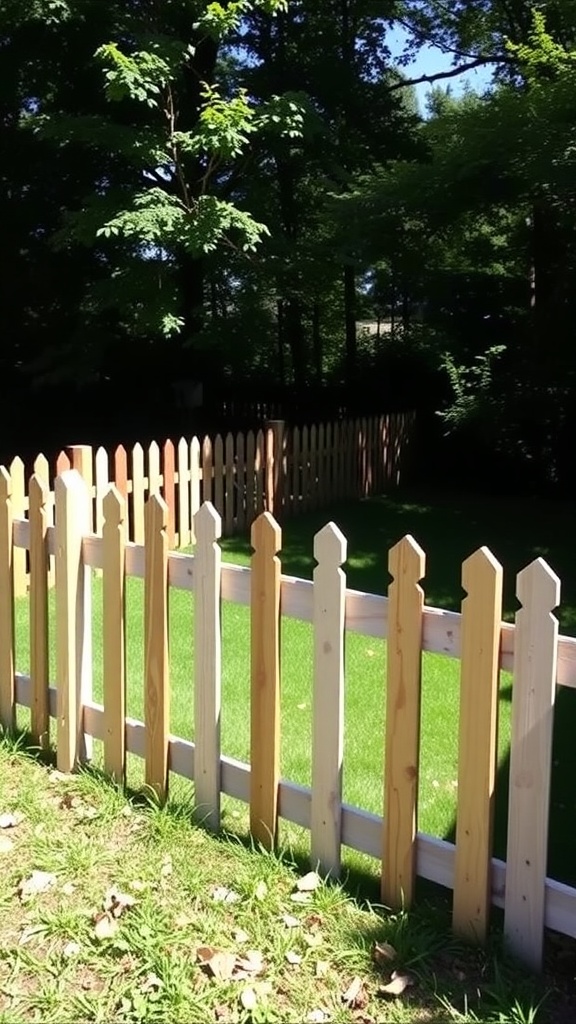
Building a dog fence doesn’t have to break the bank. If you look at this image, you can see a simple yet effective wooden fence. It’s a great example of how you can create a safe space for your dog without spending too much.
The fence in the image is made of wooden panels, showcasing a charming and classic design. It’s not only functional but also adds a nice touch to the yard. You can see how the light hits the wood, giving it a warm, inviting feel.
A DIY fence like this can be made with some basic materials. You’d need wooden planks, nails, and maybe a little paint or stain to protect the wood. This kind of project is perfect for a weekend and can be completed with just a few tools.
Think about the size of your yard and your dog’s needs. This fence design provides enough visibility while keeping your pet contained. It’s also low-maintenance, making it a practical choice for anyone looking for budget-friendly DIY dog fence ideas.
Creating a Barrier to Keep Dogs Safe
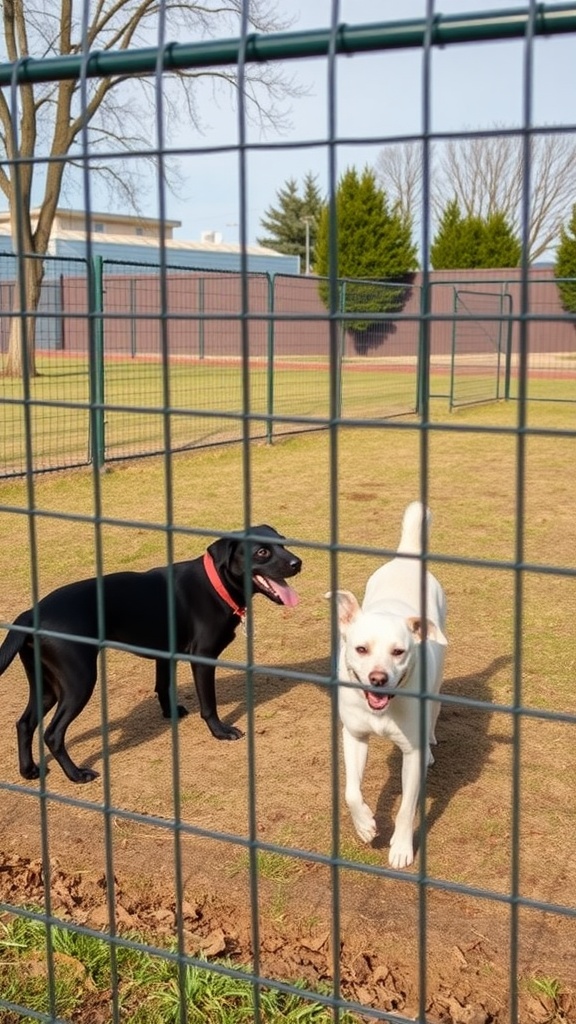
Creating a safe space for your dogs is key to ensuring their happiness and security. An effective dog fence can keep them contained while allowing them to enjoy the outdoors. In the image, we see two dogs happily playing inside a fenced area. The design features sturdy wire fencing that acts as a reliable barrier.
When setting up a dog fence, it’s important to consider the size and temperament of your dogs. You want to provide enough space for them to roam and play. The two pups in the picture look relaxed and content, which shows how a good fence can give dogs the freedom to enjoy their environment safely.
Consider using materials that blend well with your yard. The green fencing here complements the grass and trees, making the area inviting. A well-placed fence can create a designated play area without obstructing the natural beauty of your yard.
Regularly check the fence for any weak spots or areas that might need repairs. Keeping it in good condition not only maintains safety but also ensures your dogs can continue to enjoy their time outside. A secure fence truly makes a difference in your dog’s outdoor experience.
Using Plants to Enhance Your Dog Fence

Creating a dog fence doesn’t have to be just functional; it can also be beautiful. Adding plants along the fence can turn a simple barrier into a lush, inviting area for your dog and your home.
In the image, you see a fence adorned with vibrant greenery. Climbing plants like vines wrap around the bars, adding a natural touch. This not only enhances the look of the fence but also provides shade and shelter for your dog.
Using plants helps soften the harsh lines of a metal fence. Consider options like climbing roses or ivy. They are easy to maintain and provide a pop of color. Moreover, plants can act as a natural barrier, making it harder for your dog to see beyond the fence, which can help reduce barking at passersby.
Planting a variety of flowers or shrubs at the base can create a lovely garden space. This can be satisfying for both you and your pet. Just make sure to choose dog-friendly plants, avoiding any that might be toxic.
Inspecting and Maintaining Your Fence
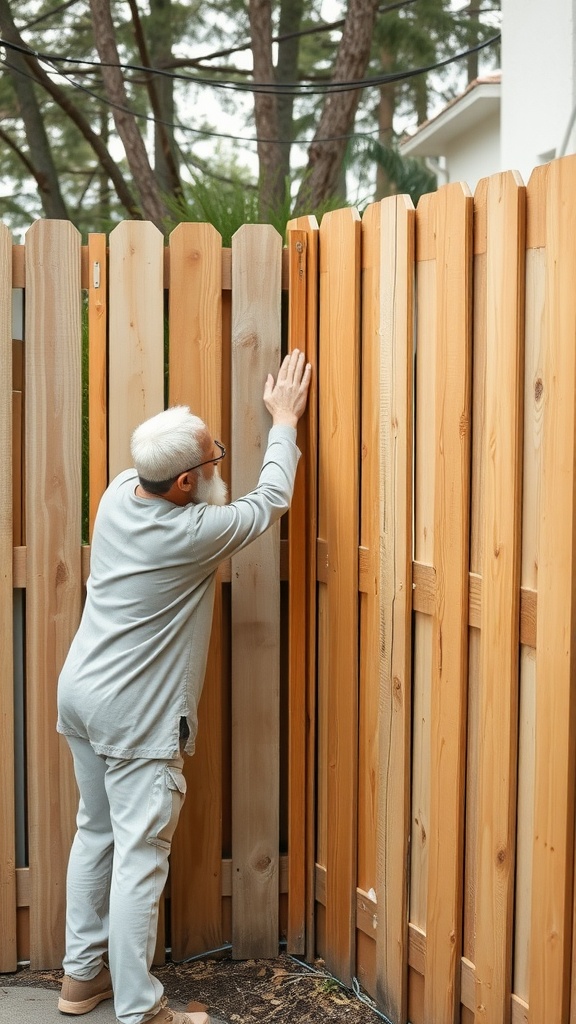
Inspecting your DIY dog fence is key to keeping it safe and sturdy. Regular checks help catch any issues early. Look for signs of wear, like loose boards or damage from weather or pests.
The image shows a person carefully examining a wooden fence. This attention to detail is important. Even small gaps can escape the notice of a curious dog. Make sure to feel for any weak spots and tighten any loose nails or screws.
Maintenance doesn’t just mean fixing things; it also involves cleaning. Remove any dirt or debris that may build up. This helps to prevent rot and extends the life of the fence.
Lastly, don’t forget to check the gates and latches. They should open and close smoothly. Making small repairs now can save you from larger problems down the road. Keeping your dog safe is the ultimate goal!
Safety Considerations When Building a Fence

When you’re building a fence for your dog, safety comes first. The image shows a simple wooden fence, perfect for keeping your pets secure. It’s important to ensure that the fence is strong enough to withstand any playful nudges from your dog.
Check for any loose boards or gaps that could let your furry friend escape. Make sure the height is adequate too; you wouldn’t want a determined pup to jump over it. The materials you choose should be durable and non-toxic, so your pets are safe while they play.
In the picture, you can see two dogs enjoying their time in a well-fenced area, a great reminder of how a proper fence can keep them secure and happy.
Also, consider your dog’s behavior. Some breeds are more prone to digging or climbing, so reinforcing the base or adding an overhang could be wise. It’s all about creating a safe space for them to enjoy the outdoors without worry.
Involving Your Dog in the Fence Building Process
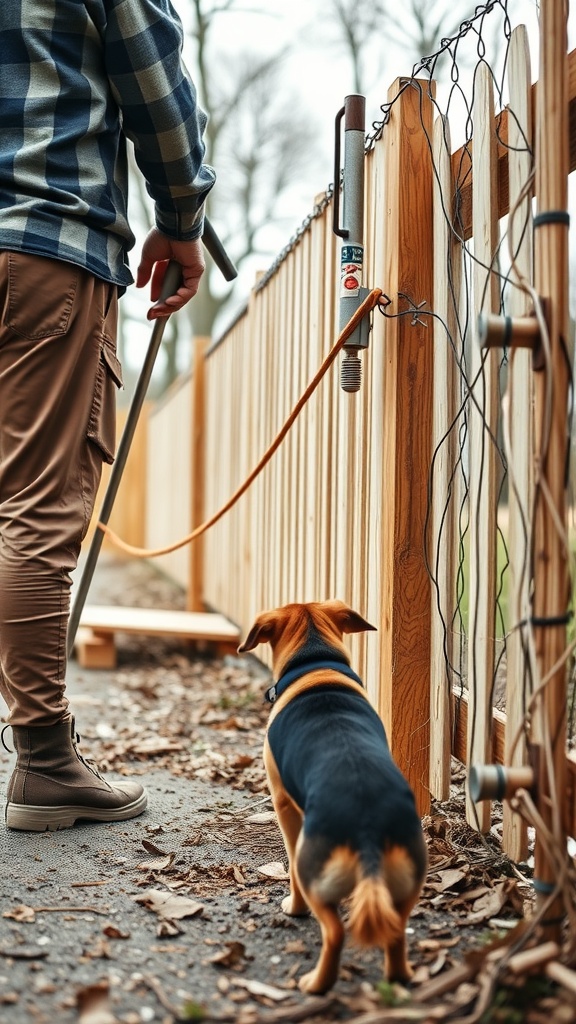
Building a fence for your dog can be a fun project, especially when you involve your furry friend in the process. In the image, we see a person standing by the fence, holding a tool, while their dog curiously explores the area. This scene captures the essence of teamwork between you and your pet.
Start by letting your dog roam the yard. This helps them get familiar with the space where the fence will go. It’s a great way for them to mark their territory and feel involved. You can encourage them by using treats or toys to reward their curiosity.
As you build, keep your dog nearby. They can watch the action and feel included. Make sure to take breaks, giving your dog chances to sniff around. This keeps them engaged and happy. Remember, a tired dog is a happy dog!
Don’t forget to consider your dog’s personality. If they’re a jumper or digger, make sure the fence is sturdy. Involving them in the planning can help you choose the right height and materials. You want to create a safe space where they can play freely.
Choosing the Right Materials for Your Dog Fence
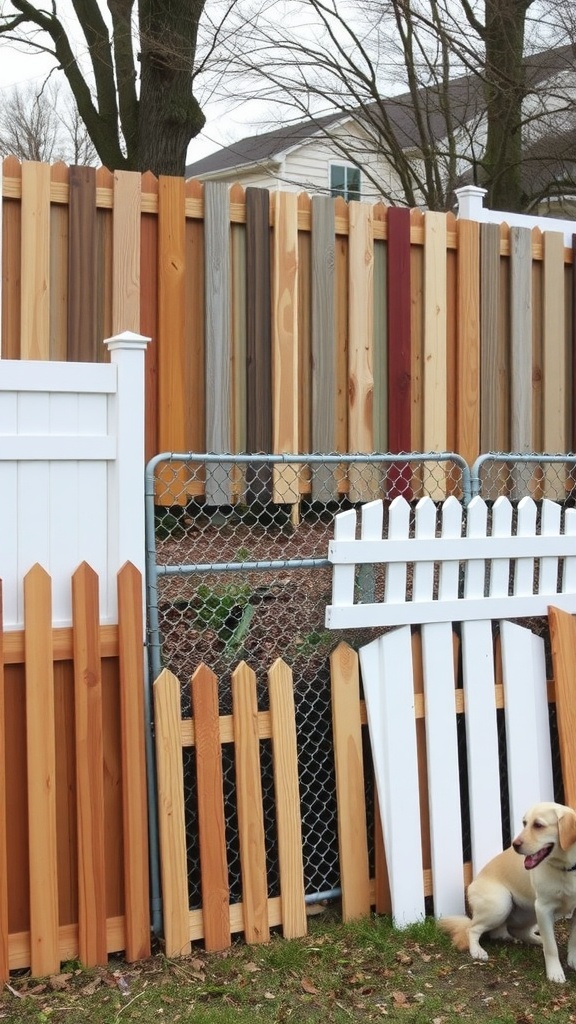
When it comes to building a dog fence, picking the right materials is key. The image shows a range of fencing options, from wooden slats to chain links. Each type has its own benefits, so let’s break them down.
Wooden fences, like the ones displayed, offer a classic look. They can provide privacy and safety for your pup. Different wood types give various aesthetics, so you can choose one that matches your yard’s feel.
Chain link fences are durable and often more affordable. While they don’t offer much privacy, they let your dog see the outside world. This can keep them entertained, but be mindful of their potential escape attempts!
The white picket fence in the image adds a charming touch. It’s great for smaller dogs and can deter them from jumping out. Plus, it blends well with gardens and landscaping.
Consider your dog’s size and behavior when choosing materials. A strong, high fence works best for adventurous dogs. On the other hand, a lower fence might suffice for smaller or less energetic breeds.

Hi, I’m Ali Tarek, the founder of Animalsman. I’ve always been passionate about pets, especially dogs and cats, and I created this website to share practical tips, easy recipes, and helpful care advice for fellow pet lovers. My goal is to make pet care simple, enjoyable, and accessible for everyone. When I’m not writing or curating content, you’ll usually find me spending time with my furry friends or learning new ways to keep them happy and healthy.



